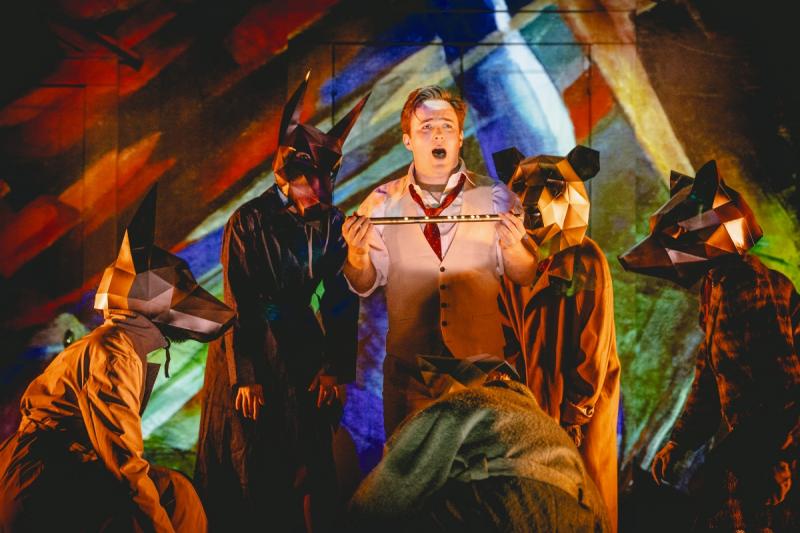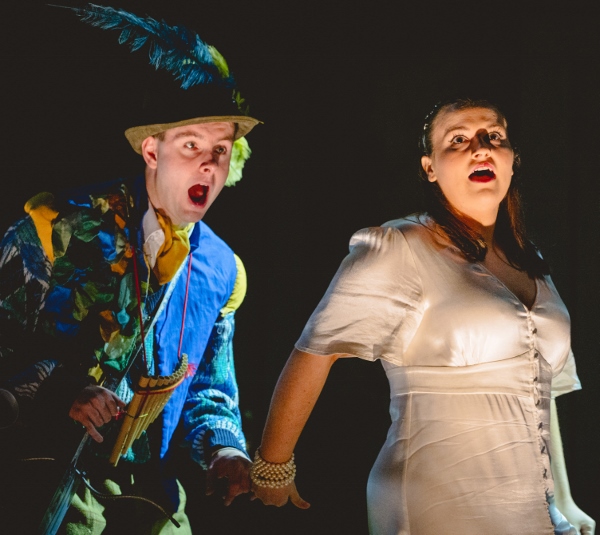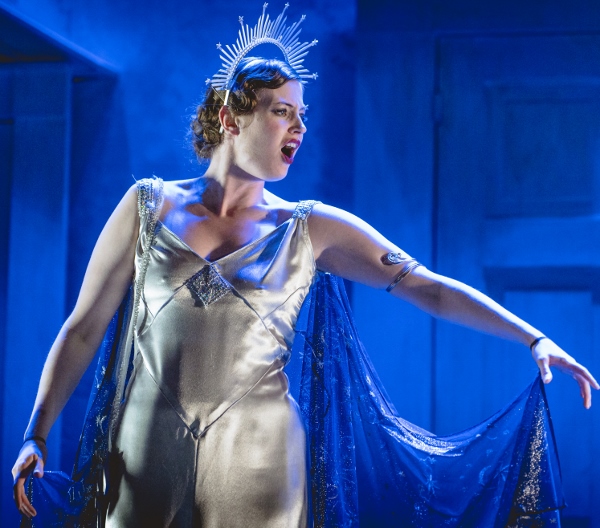The Magic Flute, Clonter Opera review - inventive ideas on the farm | reviews, news & interviews
The Magic Flute, Clonter Opera review - inventive ideas on the farm
The Magic Flute, Clonter Opera review - inventive ideas on the farm
Cheshire platform for emerging talent comes up with the goods again

Necessity has to be the mother of invention for many operatic enterprises these days – and there are few with such inventive powers as those of Clonter Opera in Cheshire.
Its avowed aim is to be a platform for emerging artists and a bridge from conservatoire training to the professional world, and its track record in achieving that for nearly 50 years is impressive. This summer production in the theatre-on-the-farm brought 10 young singers together, bursting with talent, and entertained its audience well.
It has to be inventive, of course. The pit in the Clonter theatre requires reduced orchestrations, and there has to be some doubling of roles, with chorus music sung by all available voices and in this case by using backstage mics at some points.
Director Michael McCaffery, however, has put imagination and invention into every detail of it, not only providing his own new English translation of the text but adapting the piece to the circumstances in some respects: his and designer Jessica Staton’s concept is that we are finding ourselves with a touring troupe of singers in the 1930s who happen upon an empty theatre. The outside world is not a friendly one, but they discover some miscellaneous costumes and some props from a previous production – very handy – and restore their faith in human values by putting on their own The Magic Flute.
Not every detail of the original story has to be explained – and it helps if you know roughly what to expect before it starts – but it was always a theatre people’s show, and these theatre people are faithful to its intentions.
So we have some mime to set that up while the 11-strong Clonter Sinfonia, led by Liz Rossi, plays the overture, and then we’re into the story with little adaptation, and only a few omissions from the score. The Three Boys appear as masks on staves held by cast members, with their music sung from off-stage by the same voices as the Three Ladies, the cast also don animal masks and become Sarastro’s community members where required, and we don’t hear or see the Armed Men.
The important thing here is the quality of the voices and their auspicious prospects for the future. One singer who is well fledged and joined the cast at short notice as Third Lady to cover an indisposition is Sarah Luttrell, already well known in Wexford: her voice quality is a delight and her professionalism showed at every turn.
 Hannah O’Brien – recent RNCM graduate and also a Wexford Opera Factory member – was Pamina and made the role the pivot of the drama as it should be: with Jordan Harding (also ex-RNCM and returning to Clonter for this production) as Papageno, the duet “To long for love is only human” (Bei Männern, welche Liebe fühlen) drew some of the most enthusiastic applause of the first Act (see picture). His acting had the authentic quality of that likeable likely lad first created by Mozart’s collaborator Emanuel Schikaneder, which should be a highly marketable ability. Her phrasing of “Ah, I feel” (Ach, ich fühls) was beautifully poised, with well-centred intonation.
Hannah O’Brien – recent RNCM graduate and also a Wexford Opera Factory member – was Pamina and made the role the pivot of the drama as it should be: with Jordan Harding (also ex-RNCM and returning to Clonter for this production) as Papageno, the duet “To long for love is only human” (Bei Männern, welche Liebe fühlen) drew some of the most enthusiastic applause of the first Act (see picture). His acting had the authentic quality of that likeable likely lad first created by Mozart’s collaborator Emanuel Schikaneder, which should be a highly marketable ability. Her phrasing of “Ah, I feel” (Ach, ich fühls) was beautifully poised, with well-centred intonation.
Naomi Rogers (ex-RNCM) was First Lady and Papagena – distinguished and vocally alive in both – and Laura Fleur was fully effective as Second Lady (and of course contributing in many other respects, as were all the female singers).
 For the Queen of the Night, Clonter has Louisa Stirland (pictured), a soprano with all the notes and impeccable control of them. What more needs to be said? If you can do that, there is little you cannot do (and she can act a mature role effectively). The men made up a strong team, too, with some rich, well moulded tone from Adam Jarman (currently at the RNCM) as the Speaker, and an imposing Irish-accented Sarastro from Fionn Ó hAlmhain (“When in this holy temple” – In diesen Heil’gen Hallen – coming across powerfully).
For the Queen of the Night, Clonter has Louisa Stirland (pictured), a soprano with all the notes and impeccable control of them. What more needs to be said? If you can do that, there is little you cannot do (and she can act a mature role effectively). The men made up a strong team, too, with some rich, well moulded tone from Adam Jarman (currently at the RNCM) as the Speaker, and an imposing Irish-accented Sarastro from Fionn Ó hAlmhain (“When in this holy temple” – In diesen Heil’gen Hallen – coming across powerfully).
Henry Ngan made an attractive near-pantomime baddie of Monastatos – the best thing to do with the role – and displayed an enviable tone quality both while doing it and in the chorus numbers.
And Jack Roberts as Tamino is that rare thing, a tenor of real power and considerable sophistication, with staying power and natural characterization.
The musical quality of the whole enterprise is down to music director and conductor Philip Sunderland, who knows the ideal speeds for every number in the piece and draws the best from all his singers.
Lighting by Pablo Fernandez Baz and the choreography by Steve Elias were both deployed to good effect, but one of the innovations of this production was the use of video projection, for which I take it the credit goes to Steve Brookfield. Both the adornments of the stage set, providing detailed, colourful extra dimensions to the design, and the “silent movie” of Pamina in Act One, were highly effective. They do much work of this kind in more highly subsidized houses nowadays and it’s good to see that Clonter is now up with the best.
- Further performances tomorrow, 27th and 29th July
rating
Explore topics
Share this article
more Opera
 Götterdämmerung, LPO, Jurowski, RFH review - outside looking and listening in, always with fascination
Every orchestral phrase and colour perfect, vocal drama often a notch below
Götterdämmerung, LPO, Jurowski, RFH review - outside looking and listening in, always with fascination
Every orchestral phrase and colour perfect, vocal drama often a notch below
 Simon Boccanegra, Hallé, Elder, Bridgewater Hall, Manchester review - thrilling, magnificent exploration
Verdi’s original version of the opera brought to exciting life
Simon Boccanegra, Hallé, Elder, Bridgewater Hall, Manchester review - thrilling, magnificent exploration
Verdi’s original version of the opera brought to exciting life
 Aci by the River, London Handel Festival, Trinity Buoy Wharf Lighthouse review - myths for the #MeToo age
Star singers shine in a Handel rarity
Aci by the River, London Handel Festival, Trinity Buoy Wharf Lighthouse review - myths for the #MeToo age
Star singers shine in a Handel rarity
 Carmen, Royal Opera review - strong women, no sexual chemistry and little stage focus
Damiano Michieletto's new production of Bizet’s masterpiece is surprisingly invertebrate
Carmen, Royal Opera review - strong women, no sexual chemistry and little stage focus
Damiano Michieletto's new production of Bizet’s masterpiece is surprisingly invertebrate
 La scala di seta, RNCM review - going heavy on the absinthe?
Rossini’s one-acter helps young performers find their talents to amuse
La scala di seta, RNCM review - going heavy on the absinthe?
Rossini’s one-acter helps young performers find their talents to amuse
 Death In Venice, Welsh National Opera review - breathtaking Britten
Sublime Olivia Fuchs production of a great operatic swansong
Death In Venice, Welsh National Opera review - breathtaking Britten
Sublime Olivia Fuchs production of a great operatic swansong
 Salome, Irish National Opera review - imaginatively charted journey to the abyss
Sinéad Campbell Wallace's corrupted princess stuns in Bruno Ravella's production
Salome, Irish National Opera review - imaginatively charted journey to the abyss
Sinéad Campbell Wallace's corrupted princess stuns in Bruno Ravella's production
 Jenůfa, English National Opera review - searing new cast in precise revival
Jennifer Davis and Susan Bullock pull out all the stops in Janáček's moving masterpiece
Jenůfa, English National Opera review - searing new cast in precise revival
Jennifer Davis and Susan Bullock pull out all the stops in Janáček's moving masterpiece
 theartsdesk in Strasbourg: crossing the frontiers
'Lohengrin' marks a remarkable singer's arrival on Planet Wagner
theartsdesk in Strasbourg: crossing the frontiers
'Lohengrin' marks a remarkable singer's arrival on Planet Wagner
 Giant, Linbury Theatre review - a vision fully realised
Sarah Angliss serves a haunting meditation on the strange meeting of giant and surgeon
Giant, Linbury Theatre review - a vision fully realised
Sarah Angliss serves a haunting meditation on the strange meeting of giant and surgeon
 Der fliegende Holländer, Royal Opera review - compellingly lucid with an austere visual beauty
Bryn Terfel's Dutchman is a subtly vampiric figure in this otherworldly interpretation
Der fliegende Holländer, Royal Opera review - compellingly lucid with an austere visual beauty
Bryn Terfel's Dutchman is a subtly vampiric figure in this otherworldly interpretation
 The Magic Flute, English National Opera review - return of an enchanted evening
Simon McBurney's dark pantomime casts its spell again
The Magic Flute, English National Opera review - return of an enchanted evening
Simon McBurney's dark pantomime casts its spell again

Add comment